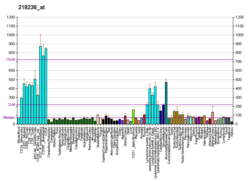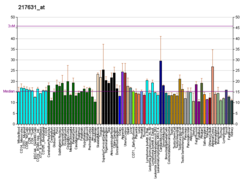Protein-coding gene in the species Homo sapiens
| GTPBP4 |
|---|
|
| Identifiers |
|---|
| Aliases | GTPBP4, CRFG, NGB, NOG1, GTP binding protein 4 |
|---|
| External IDs | MGI: 1916487; HomoloGene: 7100; GeneCards: GTPBP4; OMA:GTPBP4 - orthologs |
|---|
| Gene location (Human) |
|---|
 | | Chr. | Chromosome 10 (human)[1] |
|---|
| | Band | 10p15.3 | Start | 988,434 bp[1] |
|---|
| End | 1,019,932 bp[1] |
|---|
|
| Gene location (Mouse) |
|---|
 | | Chr. | Chromosome 13 (mouse)[2] |
|---|
| | Band | 13|13 A1 | Start | 9,016,367 bp[2] |
|---|
| End | 9,046,119 bp[2] |
|---|
|
| RNA expression pattern |
|---|
| Bgee | | Human | Mouse (ortholog) |
|---|
| Top expressed in | - sperm
- epithelium of nasopharynx
- Achilles tendon
- mucosa of urinary bladder
- amniotic fluid
- cartilage tissue
- stromal cell of endometrium
- Skeletal muscle tissue of rectus abdominis
- right adrenal cortex
- gastrocnemius muscle
|
| | Top expressed in | - otic placode
- saccule
- otic vesicle
- morula
- morula
- epiblast
- embryo
- blastocyst
- Ileal epithelium
- primitive streak
|
| | More reference expression data |
|
|---|
| BioGPS | 

 | | More reference expression data |
|
|---|
|
| Gene ontology |
|---|
| Molecular function | - nucleotide binding
- GTP binding
- protein binding
- GTPase activity
- RNA binding
| | Cellular component | - cytoplasm
- Golgi apparatus
- nuclear membrane
- membrane
- nucleolus
- perinuclear region of cytoplasm
- nucleus
- cytosol
| | Biological process | - regulation of cyclin-dependent protein serine/threonine kinase activity
- ribosome biogenesis
- negative regulation of cell-cell adhesion
- protein stabilization
- negative regulation of DNA replication
- negative regulation of protein ubiquitination
- negative regulation of cell migration
- osteoblast differentiation
- negative regulation of collagen binding
- negative regulation of cell population proliferation
- maturation of LSU-rRNA from tricistronic rRNA transcript (SSU-rRNA, 5.8S rRNA, LSU-rRNA)
| | Sources:Amigo / QuickGO |
|
| Orthologs |
|---|
| Species | Human | Mouse |
|---|
| Entrez | | |
|---|
| Ensembl | | |
|---|
| UniProt | | |
|---|
| RefSeq (mRNA) | | |
|---|
| RefSeq (protein) | | |
|---|
| Location (UCSC) | Chr 10: 0.99 – 1.02 Mb | Chr 13: 9.02 – 9.05 Mb |
|---|
| PubMed search | [3] | [4] |
|---|
|
| Wikidata |
| View/Edit Human | View/Edit Mouse |
|
Nucleolar GTP-binding protein 1 is a protein that in humans is encoded by the GTPBP4 gene.[5][6]
GTPases function as molecular switches that can flip between two states: active, when GTP is bound, and inactive, when GDP is bound. 'Active' usually means that the molecule acts as a signal to trigger other events in the cell. When an extracellular ligand binds to a G protein-coupled receptor, the receptor changes its conformation and switches on the trimeric G proteins that associate with it by causing them to eject their GDP and replace it with GTP. The switch is turned off when the G protein hydrolyzes its own bound GTP, converting it back to GDP. But before that occurs, the active protein has an opportunity to diffuse away from the receptor and deliver its message for a prolonged period to its downstream target.[6]
References
- ^ a b c GRCh38: Ensembl release 89: ENSG00000107937 – Ensembl, May 2017
- ^ a b c GRCm38: Ensembl release 89: ENSMUSG00000021149 – Ensembl, May 2017
- ^ "Human PubMed Reference:". National Center for Biotechnology Information, U.S. National Library of Medicine.
- ^ "Mouse PubMed Reference:". National Center for Biotechnology Information, U.S. National Library of Medicine.
- ^ Laping NJ, Olson BA, Zhu Y (Apr 2001). "Identification of a novel nuclear guanosine triphosphate-binding protein differentially expressed in renal disease". J Am Soc Nephrol. 12 (5): 883–90. doi:10.1681/ASN.V125883. PMID 11316846.
- ^ a b "Entrez Gene: GTPBP4 GTP binding protein 4".
Further reading
- Maruyama K, Sugano S (1994). "Oligo-capping: a simple method to replace the cap structure of eukaryotic mRNAs with oligoribonucleotides". Gene. 138 (1–2): 171–4. doi:10.1016/0378-1119(94)90802-8. PMID 8125298.
- Suzuki Y, Yoshitomo-Nakagawa K, Maruyama K, et al. (1997). "Construction and characterization of a full length-enriched and a 5'-end-enriched cDNA library". Gene. 200 (1–2): 149–56. doi:10.1016/S0378-1119(97)00411-3. PMID 9373149.
- Scherl A, Couté Y, Déon C, et al. (2003). "Functional proteomic analysis of human nucleolus". Mol. Biol. Cell. 13 (11): 4100–9. doi:10.1091/mbc.E02-05-0271. PMC 133617. PMID 12429849.
- Strausberg RL, Feingold EA, Grouse LH, et al. (2003). "Generation and initial analysis of more than 15,000 full-length human and mouse cDNA sequences". Proc. Natl. Acad. Sci. U.S.A. 99 (26): 16899–903. Bibcode:2002PNAS...9916899M. doi:10.1073/pnas.242603899. PMC 139241. PMID 12477932.
- Ota T, Suzuki Y, Nishikawa T, et al. (2004). "Complete sequencing and characterization of 21,243 full-length human cDNAs". Nat. Genet. 36 (1): 40–5. doi:10.1038/ng1285. PMID 14702039.
- Gerhard DS, Wagner L, Feingold EA, et al. (2004). "The status, quality, and expansion of the NIH full-length cDNA project: the Mammalian Gene Collection (MGC)". Genome Res. 14 (10B): 2121–7. doi:10.1101/gr.2596504. PMC 528928. PMID 15489334.
- Olsen JV, Blagoev B, Gnad F, et al. (2006). "Global, in vivo, and site-specific phosphorylation dynamics in signaling networks". Cell. 127 (3): 635–48. doi:10.1016/j.cell.2006.09.026. PMID 17081983. S2CID 7827573.
- Lee H, Kim D, Dan HC, et al. (2007). "Identification and characterization of putative tumor suppressor NGB, a GTP-binding protein that interacts with the neurofibromatosis 2 protein". Mol. Cell. Biol. 27 (6): 2103–19. doi:10.1128/MCB.00572-06. PMC 1820506. PMID 17210637.
- Ewing RM, Chu P, Elisma F, et al. (2007). "Large-scale mapping of human protein-protein interactions by mass spectrometry". Mol. Syst. Biol. 3 (1): 89. doi:10.1038/msb4100134. PMC 1847948. PMID 17353931.




















